Shikoku Bike Tour Part 1 - 四国の自転車旅その1
Over our winter holidays, we spent two weeks more or less circumnavigating Shikoku, the smallest of the four large Japanese islands, by bicycle.
Usually, we like to restrict our rambles to uninhabited, usually mountainous regions, especially in this country where the populated areas are truly not very interesting to look at. But on a trip like this, and especially because in the winter it is more difficult to pass through mountains unhindered by conditions, we elected to cycle through long stretches of urban, semi-urban, and industrial environment as well. Perhaps next time we'd better take our car to get through this and spend more time in the hills, but we did appreciate the holistic feeling of completing the whole tour (except ferries) on our own power. It was a kind of Zen exercise, pushing though the ramshackle scenery that is most of built-up Japan, all the while resisting the cold of the relatively mild but persistent winter conditions of western Japan. And the mountains and sea, as always, were peaceful and beautiful.
二週間の冬休みの間、自転車で四国を一周しました。自転車旅をする時、都会に行かずに一番山の中の田舎の風景のほうを目指していく。でも冬の間雪に覆われている山の峠を越えるのが難しいので今回工業地域や市街地の方も漕いだ。フェリー以外全部人力で移動したかったので余り好きじゃないな都会の風景でも自転車で通った。時に一日中ずっと中建物密集地域を漕いで、厳しい寒さを耐えながらまるで修行僧のようでした。やっとのどかな車が少ない海と山の風景に戻ったら穏やかな気持ちになりました。

We began on the Sadamisaki Peninsula, a long narrow strip of hilly land that extends toward Kyushu, from where we arrived by a convenient ferry. For the first time in Japan, we strapped panniers to our bikes to take the load off our backs and behinds. This way we were able to bring more gear for warmth and spent nights in our tent in reasonable comfort. The Canadian-made Arkel panniers performed flawlessly throughout the trip.
九州から四国の愛媛県の佐田岬までの便利なフェリーに乗ってそこから自転車旅を始めた。今回アケールと言うカナダ製の自転車パ二アを自転車に付けて、暖かい服、寝袋、携帯ストーブなどを持ってきました。

Japan's surprisingly ramshackle habitations look much better if they are situated in the countryside, like this old house amidst the ubiquitous orange groves of the peninsula.
ミカン畑に囲まれている民家の風景。愛媛県の代表。
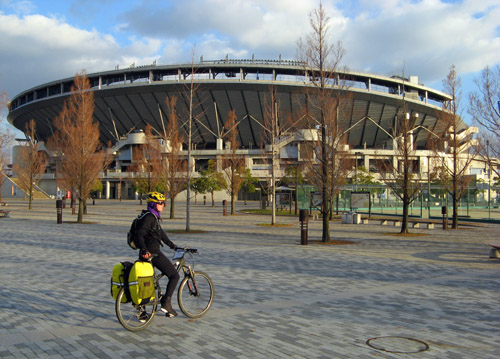
The first city we needed to traverse was Matsuyama, Shikoku's largest with a population of 510,000. We were surprised by the modern appearance and preponderance of large, brand-new-looking shopping malls of this town, as well as a huge sports and culture complex we happened upon. In an indication of where the Japanese society is heading, the malls were very crowded, whereas the culture complex was virtually deserted. We even visited a friendly MTB bike shop "Western Cycle House" which Leanne had geocoded in our GPSs before the trip. The staff greeted us with friendly chatter, freshly made rice cakes and green tea. We even appeared on their BLOG.
人口51万の四国に二番目大きいな市の松山市を漕いで圧倒的多数の新しそうで大きい時現代建築があったから驚きました。旅に出る前に万が一自転車に問題があるためにMTBの店を家のパソコンに調べて、GPSに入れ込んだ。松山市にサイクルハウス ウエスタンを訪れってやさしいスタッフから新年の御餅とお茶を頂いた。店のブログにも載っていました。

After Matsuyama we crossed a range of hills, camping off a small road circling a reservoir. That morning, like the rest of the trip, it was chilly and we balanced our effort climbing the hill to stay warm but to avoid sweating.
松山市から小さい山を越えて、ダムの近くでキャンプしました。次の日の朝、坂を登っていた時汗を掻かないようにゆっくり漕いで体を温めました。(汗を掻くと後で冷えるから)。

Here and there in the rural countryside, attractive semi-traditional houses are still to be seen. In the cities most have been replaced with cheap-looking, plastic sided habitations.
都会で珍しくなってきた伝統的な家は田舎の方ではまだ多くあります。

As we neared the top of the hill on the smooth, wide highway, we were passed by several cyclists. We met up at on the road's summit where everyone availed themselves of hot drinks from the vending machines. They were from the local track cycling club which explained their (relative) struggle climbing: their track bikes had no gears! Of course with our loads and clunky mountain bikes, we were still slower. After a nice chat, we forged on though a long tunnel underneath the mountain.
坂の途中に私は自転車のチームに追い越されて峠の近くの自動販売機でまた会って、実は競輪選手だった。しばらく一緒に休憩してから別れました。

Our nourishment along the way consisted largely of ramen and udon noodles or karaage fried chicken at roadside restaurants such as this one, and assorted junk food from convenience stores. We ate prodigious quantities, for we needed energy not only for cycling but to stay warm throughout the day and night. It was perhaps not the best fuel, and somewhat expensive, but we did not have the option of carrying too much food with us as our bikes were already overloaded with warm clothes and camping gear. While stopped during the day we often tried to dry our damp gear as you can see here.
旅の途中にだいたいラーメン、うどん、唐揚げやコンビニのおやつを食べました。一日中漕いで、夜もキャンプをしたのでかなりの量を食べないと夜はものすごく寒かった。
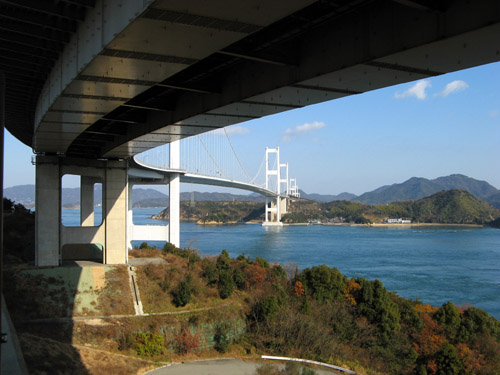
Descending again to the sea, we neared our first objective: the bridges of the Shimanami Highway, one of three massive bridge systems that link Shikoku to the Japanese mainland of Honshu. The Shimanami is the only one that is passable by bike and in fact a special bike route has been built that makes the crossings fun, exciting, and safe.
山から下りたら、しまなみ瀬戸内海横断自転車道を利用して本州まで渡りました。この自転車専用道は最高。海を眺めながら車にビクビクしなくて、わき見しながら気楽に走れます。お勧めです。レンタルもあるです。
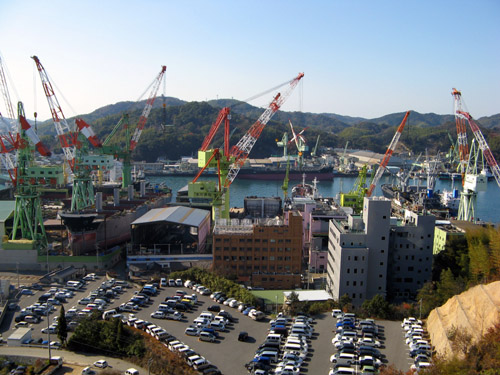
Climbing up to the bridges, one can enjoy views of Japan's Inland Sea and the industrial complexes that line much of its shores, like this ship-building yard in the city of Imabari.
橋から瀬戸内海の海岸に並んでいる造船の工場が沢山見えます。

The first set of bridges span the Kurushima Strait, a busy channel that is infamous among ship captains because it's narrow, crooked, and beset with strong tidal currents. On this morning, however, conditions were good and shipping relatively sparse.
最初の橋は曲がりくねった狭い海峡を横切る。この海峡は海流が激しくて通りに憎いので船長の間で有名です。
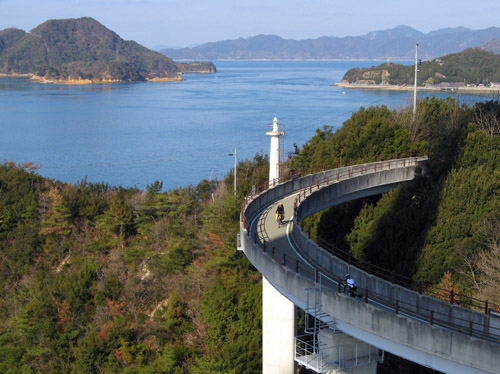
Leanne descends the bicycle off-ramp on one of the bridges. We were delighted to see other cyclists, including families with small children, traversing the bridges. Most recreational facilities get little use in Japan, so it was nice to see an exception.
橋から下りる時自転車専用出口ランプがあります。サイクリス、徒歩旅行者、家族などさまざま人がサイクリングロードを利用していました。人気があります。
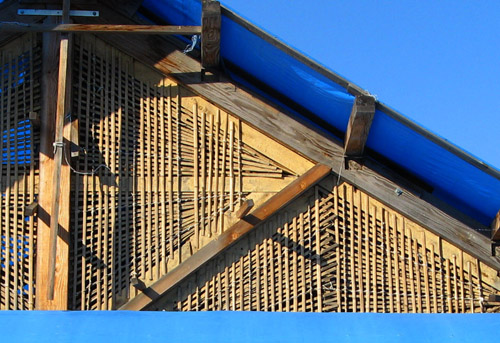
Although some of the many sizeable islands in the Inland Sea are now linked to the mainland by bridges, they still seem a little less 'modernized' than Japan's mainland. That's also evident in this modest house under construction, where a bamboo lattice will form the framework for a mud wall. In this day of drywall and plastic siding, such a traditional approach is rare indeed to see on a new house.
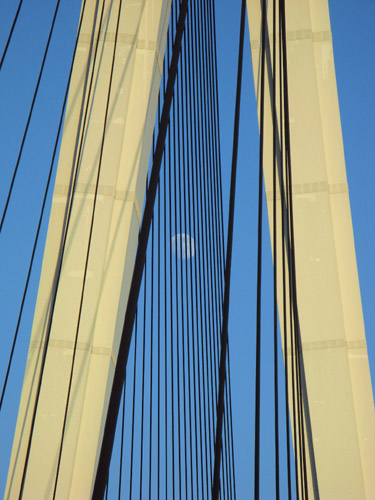
A gibbous moon rises behind the cables and pylons of a gigantic suspension bridge that spans the sea between Ehime and Hiroshima Prefectures. We had moonlight almost every night, which came in useful in the evenings as we compensated for the short daylight hours (and frigid mornings) by biking an hour or two into the evening darkness.
愛媛県と広島県に架かっている橋を渡るときさやかに輝く凸月が巨大なつり橋のケーブルの後ろから昇る。月が出ている時は、屋外の方が、ものがよく見えますので殆ど毎日、暗くなってから2-3時間も漕ぎ続きました。
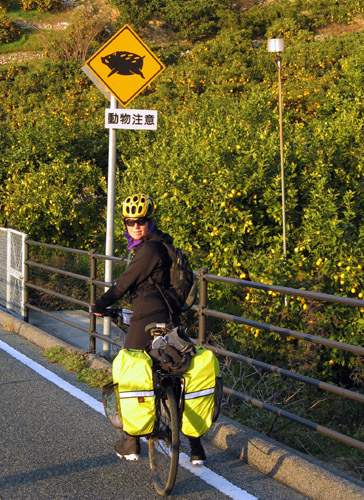
Wild boars are common in most parts of Japan, even on some of the outlying islands where, surprisingly, they are able to swim over considerable distances in the sea. The one on this sign somehow bears a striking resemblance to Leanne!
猪は泳ぐのは上手です。島から島まで泳ぐそうです。驚きます。
里杏と似てない?!

By the time we got to the final bridge of the 70km long Shimanami Kaido biking trail, it was dark but the bridge itself was nicely lit.
しまなみ瀬戸内海横断自転車道の最後の橋を渡った時もう暗くになってきて、橋が綺麗にライトアップされました。
Usually, we like to restrict our rambles to uninhabited, usually mountainous regions, especially in this country where the populated areas are truly not very interesting to look at. But on a trip like this, and especially because in the winter it is more difficult to pass through mountains unhindered by conditions, we elected to cycle through long stretches of urban, semi-urban, and industrial environment as well. Perhaps next time we'd better take our car to get through this and spend more time in the hills, but we did appreciate the holistic feeling of completing the whole tour (except ferries) on our own power. It was a kind of Zen exercise, pushing though the ramshackle scenery that is most of built-up Japan, all the while resisting the cold of the relatively mild but persistent winter conditions of western Japan. And the mountains and sea, as always, were peaceful and beautiful.
二週間の冬休みの間、自転車で四国を一周しました。自転車旅をする時、都会に行かずに一番山の中の田舎の風景のほうを目指していく。でも冬の間雪に覆われている山の峠を越えるのが難しいので今回工業地域や市街地の方も漕いだ。フェリー以外全部人力で移動したかったので余り好きじゃないな都会の風景でも自転車で通った。時に一日中ずっと中建物密集地域を漕いで、厳しい寒さを耐えながらまるで修行僧のようでした。やっとのどかな車が少ない海と山の風景に戻ったら穏やかな気持ちになりました。

We began on the Sadamisaki Peninsula, a long narrow strip of hilly land that extends toward Kyushu, from where we arrived by a convenient ferry. For the first time in Japan, we strapped panniers to our bikes to take the load off our backs and behinds. This way we were able to bring more gear for warmth and spent nights in our tent in reasonable comfort. The Canadian-made Arkel panniers performed flawlessly throughout the trip.
九州から四国の愛媛県の佐田岬までの便利なフェリーに乗ってそこから自転車旅を始めた。今回アケールと言うカナダ製の自転車パ二アを自転車に付けて、暖かい服、寝袋、携帯ストーブなどを持ってきました。

Japan's surprisingly ramshackle habitations look much better if they are situated in the countryside, like this old house amidst the ubiquitous orange groves of the peninsula.
ミカン畑に囲まれている民家の風景。愛媛県の代表。

The first city we needed to traverse was Matsuyama, Shikoku's largest with a population of 510,000. We were surprised by the modern appearance and preponderance of large, brand-new-looking shopping malls of this town, as well as a huge sports and culture complex we happened upon. In an indication of where the Japanese society is heading, the malls were very crowded, whereas the culture complex was virtually deserted. We even visited a friendly MTB bike shop "Western Cycle House" which Leanne had geocoded in our GPSs before the trip. The staff greeted us with friendly chatter, freshly made rice cakes and green tea. We even appeared on their BLOG.
人口51万の四国に二番目大きいな市の松山市を漕いで圧倒的多数の新しそうで大きい時現代建築があったから驚きました。旅に出る前に万が一自転車に問題があるためにMTBの店を家のパソコンに調べて、GPSに入れ込んだ。松山市にサイクルハウス ウエスタンを訪れってやさしいスタッフから新年の御餅とお茶を頂いた。店のブログにも載っていました。

After Matsuyama we crossed a range of hills, camping off a small road circling a reservoir. That morning, like the rest of the trip, it was chilly and we balanced our effort climbing the hill to stay warm but to avoid sweating.
松山市から小さい山を越えて、ダムの近くでキャンプしました。次の日の朝、坂を登っていた時汗を掻かないようにゆっくり漕いで体を温めました。(汗を掻くと後で冷えるから)。

Here and there in the rural countryside, attractive semi-traditional houses are still to be seen. In the cities most have been replaced with cheap-looking, plastic sided habitations.
都会で珍しくなってきた伝統的な家は田舎の方ではまだ多くあります。

As we neared the top of the hill on the smooth, wide highway, we were passed by several cyclists. We met up at on the road's summit where everyone availed themselves of hot drinks from the vending machines. They were from the local track cycling club which explained their (relative) struggle climbing: their track bikes had no gears! Of course with our loads and clunky mountain bikes, we were still slower. After a nice chat, we forged on though a long tunnel underneath the mountain.
坂の途中に私は自転車のチームに追い越されて峠の近くの自動販売機でまた会って、実は競輪選手だった。しばらく一緒に休憩してから別れました。

Our nourishment along the way consisted largely of ramen and udon noodles or karaage fried chicken at roadside restaurants such as this one, and assorted junk food from convenience stores. We ate prodigious quantities, for we needed energy not only for cycling but to stay warm throughout the day and night. It was perhaps not the best fuel, and somewhat expensive, but we did not have the option of carrying too much food with us as our bikes were already overloaded with warm clothes and camping gear. While stopped during the day we often tried to dry our damp gear as you can see here.
旅の途中にだいたいラーメン、うどん、唐揚げやコンビニのおやつを食べました。一日中漕いで、夜もキャンプをしたのでかなりの量を食べないと夜はものすごく寒かった。

Descending again to the sea, we neared our first objective: the bridges of the Shimanami Highway, one of three massive bridge systems that link Shikoku to the Japanese mainland of Honshu. The Shimanami is the only one that is passable by bike and in fact a special bike route has been built that makes the crossings fun, exciting, and safe.
山から下りたら、しまなみ瀬戸内海横断自転車道を利用して本州まで渡りました。この自転車専用道は最高。海を眺めながら車にビクビクしなくて、わき見しながら気楽に走れます。お勧めです。レンタルもあるです。

Climbing up to the bridges, one can enjoy views of Japan's Inland Sea and the industrial complexes that line much of its shores, like this ship-building yard in the city of Imabari.
橋から瀬戸内海の海岸に並んでいる造船の工場が沢山見えます。

The first set of bridges span the Kurushima Strait, a busy channel that is infamous among ship captains because it's narrow, crooked, and beset with strong tidal currents. On this morning, however, conditions were good and shipping relatively sparse.
最初の橋は曲がりくねった狭い海峡を横切る。この海峡は海流が激しくて通りに憎いので船長の間で有名です。

Leanne descends the bicycle off-ramp on one of the bridges. We were delighted to see other cyclists, including families with small children, traversing the bridges. Most recreational facilities get little use in Japan, so it was nice to see an exception.
橋から下りる時自転車専用出口ランプがあります。サイクリス、徒歩旅行者、家族などさまざま人がサイクリングロードを利用していました。人気があります。

Although some of the many sizeable islands in the Inland Sea are now linked to the mainland by bridges, they still seem a little less 'modernized' than Japan's mainland. That's also evident in this modest house under construction, where a bamboo lattice will form the framework for a mud wall. In this day of drywall and plastic siding, such a traditional approach is rare indeed to see on a new house.

A gibbous moon rises behind the cables and pylons of a gigantic suspension bridge that spans the sea between Ehime and Hiroshima Prefectures. We had moonlight almost every night, which came in useful in the evenings as we compensated for the short daylight hours (and frigid mornings) by biking an hour or two into the evening darkness.
愛媛県と広島県に架かっている橋を渡るときさやかに輝く凸月が巨大なつり橋のケーブルの後ろから昇る。月が出ている時は、屋外の方が、ものがよく見えますので殆ど毎日、暗くなってから2-3時間も漕ぎ続きました。

Wild boars are common in most parts of Japan, even on some of the outlying islands where, surprisingly, they are able to swim over considerable distances in the sea. The one on this sign somehow bears a striking resemblance to Leanne!
猪は泳ぐのは上手です。島から島まで泳ぐそうです。驚きます。
里杏と似てない?!

By the time we got to the final bridge of the 70km long Shimanami Kaido biking trail, it was dark but the bridge itself was nicely lit.
しまなみ瀬戸内海横断自転車道の最後の橋を渡った時もう暗くになってきて、橋が綺麗にライトアップされました。
Labels: shikoku bike tour 四国自転車ツアー


1 Comments:
いつも、旅の報告を見るのを楽しみにしてます。
今回もすばらしい自転車旅行だったみたいだね!特に、しまなみ~自転車道路は私もいつか絶対行ってみたいと思いました!!
ハイキングはとても楽しかった~
雪山最高だね!
いつもありがとう!
By kazumi, at 1:22 pm
kazumi, at 1:22 pm
Post a Comment
<< Home